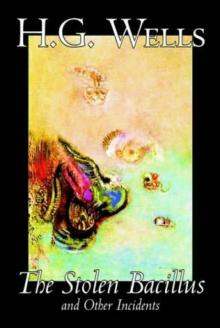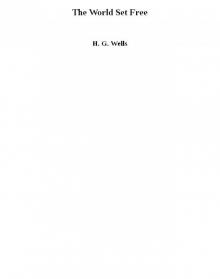- Home
- H. G. Wells
The War of the Worlds (Penguin Classics) Page 4
The War of the Worlds (Penguin Classics) Read online
Page 4
P.P.
Note on the Text
H. G. Wells started planning The War of the Worlds shortly after his move in May 1895 to ‘Lynton’, Maybury Road, Woking, Surrey, a much humbler address than his narrator’s house on nearby Maybury Hill. It was on a visit to Woking that Wells’s elder brother Frank first speculated about an invasion from Mars. Soon Wells began cycling around Woking marking out locations for the story. Later, he dedicated the first edition of The War of the Worlds ‘To my brother Frank Wells, this rendering of his idea’.
In January 1896 he sent an outline of the story to W. M. Coles of the Authors’ Syndicate, a literary agency, and by 14 March Coles was able to report an expression of interest by the proprietor of Pearson’s Magazine, C. A. Pearson. Coles, however, reported Pearson’s opinion that ‘a great deal depends on the finish of the story’. Wells then drew a pen-and-ink cartoon strip with the caption ‘Very nice tale so far but do you mind taking the End out of the inkpot before I decide’ – later reproduced in Chapter 8 of Experiment in Autobiography (1934) – on Coles’s letter.1 Pearson evidently did like the ending, since The War of the Worlds first appeared as an illustrated monthly serial in Pearson’s Magazine and in the New York Cosmopolitan between April and December 1897. The story quickly became notorious. In early 1898, pirated versions appeared in Boston and New York newspapers, with the locations switched so that the Martian invasion was directly aimed at the city concerned.
Book publication was by William Heinemann in London in January 1898, and by Harper in New York in March. The Harper edition lacks the Epilogue. Wells, however, used the Harper edition (plus the Epilogue) in preparing the slightly revised and corrected text that appeared in Volume III of the Atlantic Edition of the Works of H. G. Wells (London: T. Fisher Unwin, and New York: Scribner’s, 1924). Two significant topographical mistakes were corrected in the Essex edition (London: Ernest Benn, 1927), which in most respects is a slightly careless reprint of the Atlantic edition. The Atlantic text fails to distinguish between Cobham (or Street Cobham) and Chobham, two separate locations in Surrey; and in Book II, Chapter 8 the narrator crosses the Thames, in the Atlantic and all earlier editions, from Putney to Lambeth, while the Essex text corrects the latter to ‘Fulham’.
The Atlantic text was undoubtedly intended as the definitive version of The War of the Worlds, and it is therefore the basis of the current edition, though with a number of modifications. Printed in the United States and published simultaneously in New York and London, the Atlantic edition was meant to follow British spelling conventions but frequently fails to do so. In many instances its spelling, punctuation and hyphenation follow the Harper edition and are the product of US copy-editing on a text that, given the circumstances of transatlantic publishing in the late nineteenth century, Wells himself cannot have seen in proof. In the present text, ‘burned’ has been changed to ‘burnt’, ‘farther’ to ‘further’, ‘gayly’ to ‘gaily’, ‘tire’ to ‘tyre’, ‘whiskey’ to ‘whisky’, etc. in accordance with Heinemann 1898. The hyphenation of some 60 compound words has been silently modernized (e.g. ‘midday’ and ‘lighthouse’ rather than ‘mid-day’ and ‘light-house’), as has the spelling of ‘wag(g)on’ and ‘wag(g)oner’. Words hyphenated in American but not in British English (‘shooting-star’, ‘falling-star’) appear as in Heinemann 1898. Changes in punctuation include the addition of commas for the sake of clarity in some 25 instances, occasional deletion of commas and changing semicolons to commas. All other substantive emendations are listed below.
Housestyling of punctuation and spelling has also been implemented to make the text more accessible to the reader: single quotation marks (for doubles) with doubles inside singles as needed; end punctuation placed outside end quotation marks when appropriate; spaced N-dashes (for the heavier, longer M-dash) and M-dashes (for the double-length 2M-dash); ‘ize’ spellings (e.g. recognize, not recognise), and acknowledgements and judgement, not acknowledgments and judgment; no full stop after personal titles (Dr, Mr, Mrs) or chapter titles, which may not follow the capitalization of the copy-text.
SOURCES OF SUBSTANTIVE EMENDATIONS
The following abbreviations have been used: E = Essex, H = Heinemann, MS = manuscript.2
SIGNIFICANT VARIANT READINGS
The following list shows Wells’s principal stylistic revisions for the Atlantic edition. In all but one case, the Harper and Heinemann readings are identical.
In preparing this edition, I have been greatly indebted to the pioneering textual scholarship of David Lake and of David Y. Hughes, editor (with Harry M. Geduld) of A Critical Edition of ‘The War of the Worlds’ (Bloomington and Indianapolis: Indiana University Press, 1993), which includes a transcript of the earliest surviving manuscript fragment of Wells’s novel. This, together with an incomplete set of revised proofs of the Pearson’s Magazine serial version, is in the Wells Collection at the Rare Book and Special Collections Library, University of Illinois at Urbana–Champaign.
P.P.
NOTES
1.H. G. Wells, Experiment in Autobiography: Discoveries and Conclusions of a Very Ordinary Brain (since 1866), 2 vols (London: Gollancz and Cresset Press, 1966), ii, p. 555.
2.The manuscript readings have been identified by David Y. Hughes.
THE WAR OF THE
WORLDS
‘But who shall dwell in these Worlds if they be inhabited? . . . Are we or they Lords of the World? . . . And how are all things made for man?’
KEPLER (quoted in ‘The Anatomy of Melancholy.’)1
Contents
BOOK I
The Coming of the Martians
1The Eve of the War
2The Falling Star
3On Horsell Common
4The Cylinder Opens
5The Heat-Ray
6The Heat-Ray in the Chobham Road
7How I Reached Home
8Friday Night
9The Fighting Begins
10In the Storm
11At the Window
12What I Saw of the Destruction of Weybridge and Shepperton
13How I Fell in with the Curate
14In London
15What had Happened in Surrey
16The Exodus from London
17The ‘Thunder Child’
BOOK II
The Earth under the Martians
1Under Foot
2What We Saw from the Ruined House
3The Days of Imprisonment
4The Death of the Curate
5The Stillness
6The Work of Fifteen Days
7The Man on Putney Hill
8Dead London
9Wreckage
10The Epilogue
BOOK I
THE COMING OF THE
MARTIANS
1
THE EVE OF THE WAR
No one would have believed, in the last years of the nineteenth century, that this world was being watched1 keenly and closely by intelligences greater than man’s and yet as mortal as his own; that as men busied themselves about their various concerns they were scrutinized and studied, perhaps almost as narrowly as a man with a microscope might scrutinize the transient creatures that swarm and multiply in a drop of water. With infinite complacency men went to and fro over this globe about their little affairs, serene in their assurance of their empire over matter. It is possible that the infusoria2 under the microscope do the same. No one gave a thought to the older worlds of space3 as sources of human danger, or thought of them only to dismiss the idea of life upon them as impossible or improbable. It is curious to recall some of the mental habits of those departed days. At most, terrestrial men fancied there might be other men upon Mars, perhaps inferior to themselves and ready to welcome a missionary enterprise. Yet across the gulf of space, minds that are to our minds as ours are to those of the beasts that perish,4 intellects vast and cool and unsympathetic, regarded this earth with envious eyes, and slowly and surely drew their plans against us. And early in the twentieth century came the g
reat disillusionment.
The planet Mars,5 I scarcely need remind the reader,6 revolves about the sun at a mean distance of 140,000,000 miles, and the light and heat it receives from the sun is barely half of that received by this world. It must be, if the nebular hypothesis7 has any truth, older than our world; and long before this earth ceased to be molten, life upon its surface must have begun its course. The fact that it is scarcely one-seventh of the volume of the earth must have accelerated its cooling to the temperature at which life could begin. It has air and water and all that is necessary for the support of animated existence.
Yet so vain is man, and so blinded by his vanity, that no writer, up to the very end of the nineteenth century, expressed any idea that intelligent life might have developed there far, or indeed at all, beyond its earthly level. Nor was it generally understood that since Mars is older than our earth, with scarcely a quarter of the superficial area and remoter from the sun, it necessarily follows that it is not only more distant from life’s beginning but nearer its end.
The secular cooling that must some day overtake our planet has already gone far indeed with our neighbour. Its physical condition is still largely a mystery, but we know now that even in its equatorial region the midday temperature barely approaches that of our coldest winter. Its air is much more attenuated than ours, its oceans have shrunk until they cover but a third of its surface, and as its slow seasons change huge snow caps gather and melt about either pole and periodically inundate its temperate zones. That last stage of exhaustion, which to us is still incredibly remote, has become a present-day problem for the inhabitants of Mars.8 The immediate pressure of necessity has brightened their intellects, enlarged their powers, and hardened their hearts. And looking across space with instruments and intelligences such as we have scarcely dreamed of, they see, at its nearest distance only 35,000,000 of miles sunward of them, a morning star of hope, our own warmer planet, green with vegetation and grey with water, with a cloudy atmosphere eloquent of fertility, with glimpses through its drifting cloud-wisps of broad stretches of populous country and narrow, navy-crowded seas.
And we men, the creatures who inhabit this earth, must be to them at least as alien and lowly as are the monkeys and lemurs to us. The intellectual side of man already admits that life is an incessant struggle for existence, and it would seem that this too is the belief of the minds upon Mars. Their world is far gone in its cooling, and this world is still crowded with life, but crowded only with what they regard as inferior animals. To carry warfare sunward is, indeed, their only escape from the destruction that generation after generation creeps upon them.
And before we judge of them too harshly we must remember what ruthless and utter destruction our own species has wrought, not only upon animals, such as the vanished bison and the dodo,9 but upon its own inferior races. The Tasmanians,10 in spite of their human likeness, were entirely swept out of existence in a war of extermination waged by European immigrants, in the space of fifty years. Are we such apostles of mercy as to complain if the Martians warred in the same spirit?
The Martians seem to have calculated their descent with amazing subtlety – their mathematical learning is evidently far in excess of ours – and to have carried out their preparations with a well-nigh perfect unanimity. Had our instruments permitted it, we might have seen the gathering trouble far back in the nineteenth century. Men like Schiaparelli11 watched the red planet – it is odd, by-the-bye, that for countless centuries Mars has been the star of war – but failed to interpret the fluctuating appearances of the markings they mapped so well. All that time the Martians must have been getting ready.
During the opposition of 189412 a great light was seen on the illuminated part of the disc, first at the Lick Observatory,13 then by Perrotin of Nice,14 and then by other observers. English readers heard of it first in the issue of Nature dated August 2nd.15 I am inclined to think that this blaze may have been the casting of the huge gun, in the vast pit sunk into their planet, from which their shots were fired at us. Peculiar markings, as yet unexplained, were seen near the site of that outbreak during the next two oppositions.
The storm burst upon us six years ago now. As Mars approached opposition, Lavelle of Java set the wires of the astronomical exchange palpitating with the amazing intelligence of a huge outbreak of incandescent gas upon the planet. It had occurred towards midnight of the 12th; and the spectroscope, to which he had at once resorted, indicated a mass of flaming gas, chiefly hydrogen, moving with an enormous velocity towards this earth. This jet of fire had become invisible about a quarter past twelve. He compared it to a colossal puff of flame suddenly and violently squirted out of the planet, ‘as flaming gases rushed out of a gun’.
A singularly appropriate phrase it proved. Yet the next day there was nothing of this in the papers except a little note in the Daily Telegraph,16 and the world went in ignorance of one of the gravest dangers that ever threatened the human race. I might not have heard of the eruption at all had I not met Ogilvy, the well-known astronomer, at Ottershaw.17 He was immensely excited at the news, and in the excess of his feelings invited me up to take a turn with him that night in a scrutiny of the red planet.
In spite of all that has happened since, I still remember that vigil very distinctly: the black and silent observatory, the shadowed lantern throwing a feeble glow upon the floor in the corner, the steady ticking of the clockwork of the telescope, the little slit in the roof – an oblong profundity with the stardust streaked across it. Ogilvy moved about, invisible but audible. Looking through the telescope, one saw a circle of deep blue and the little round planet swimming in the field. It seemed such a little thing, so bright and small and still, faintly marked with transverse stripes, and slightly flattened from the perfect round. But so little it was, so silvery warm – a pin’s head of light! It was as if it quivered, but really this was the telescope vibrating with the activity of the clockwork that kept the planet in view.
As I watched, the planet seemed to grow larger and smaller and to advance and recede, but that was simply that my eye was tired. Forty millions of miles it was from us – more than forty millions of miles of void. Few people realize the immensity of vacancy in which the dust of the material universe swims.
Near it in the field, I remember, were three faint points of light, three telescopic stars infinitely remote, and all around it was the unfathomable darkness of empty space. You know how that blackness looks on a frosty starlight night. In a telescope it seems far profounder. And invisible to me, because it was so remote and small, flying swiftly and steadily towards me across that incredible distance, drawing nearer every minute by so many thousands of miles, came the Thing they were sending us, the Thing that was to bring so much struggle and calamity and death to the earth. I never dreamt of it then as I watched; no one on earth dreamt of that unerring missile.
That night, too, there was another jetting out of gas from the distant planet. I saw it. A reddish flash at the edge, the slightest projection of the outline just as the chronometer struck midnight; and at that I told Ogilvy and he took my place. The night was warm and I was thirsty, and I went, stretching my legs clumsily and feeling my way in the darkness, to the little table where the siphon stood, while Ogilvy exclaimed at the streamer of gas that came out towards us.
That night another invisible missile started on its way to the earth from Mars, just a second or so under twenty-four hours after the first one. I remember how I sat on the table there in the blackness, with patches of green and crimson swimming before my eyes. I wished I had a light to smoke by, little suspecting the meaning of the minute gleam I had seen and all that it would presently bring me. Ogilvy watched till one, and then gave it up; and we lit the lantern and walked over to his house. Down below in the darkness were Ottershaw and Chertsey and all their hundreds of people, sleeping in peace.
He was full of speculation that night about the condition of Mars, and scoffed at the vulgar idea of its having inhabitants who were si
gnalling us. His idea was that meteorites might be falling in a heavy shower upon the planet, or that a huge volcanic explosion was in progress. He pointed out to me how unlikely it was that organic evolution had taken the same direction in the two adjacent planets.
‘The chances against anything man-like on Mars are a million to one,’ he said.
Hundreds of observers saw the flame that night and the night after, about midnight, and again the night after; and so for ten nights, a flame each night. Why the shots ceased after the tenth no one on earth has attempted to explain. It may be the gases of the firing caused the Martians inconvenience. Dense clouds of smoke or dust, visible through a powerful telescope on earth as little grey, fluctuating patches, spread through the clearness of the planet’s atmosphere and obscured its more familiar features.

 Ann Veronica: A Modern Love Story
Ann Veronica: A Modern Love Story The Time Machine
The Time Machine The First Men in the Moon
The First Men in the Moon The Stolen Bacillus and Other Incidents
The Stolen Bacillus and Other Incidents The War of the Worlds
The War of the Worlds The Invisible Man: A Grotesque Romance
The Invisible Man: A Grotesque Romance The Island of Doctor Moreau
The Island of Doctor Moreau The Door in the Wall, and Other Stories
The Door in the Wall, and Other Stories The Best Science Fiction Stories of H G Wells
The Best Science Fiction Stories of H G Wells The Sea Lady
The Sea Lady The Wonderful Visit
The Wonderful Visit Love and Mr. Lewisham
Love and Mr. Lewisham Marriage
Marriage Tales of Space and Time
Tales of Space and Time The War of the Worlds (Penguin Classics)
The War of the Worlds (Penguin Classics) Twelve Stories and a Dream
Twelve Stories and a Dream The Food of the Gods and How It Came to Earth
The Food of the Gods and How It Came to Earth Tono-Bungay
Tono-Bungay The War in the Air
The War in the Air The Sleeper Awakes
The Sleeper Awakes The Country of the Blind and Other Stories
The Country of the Blind and Other Stories Kipps
Kipps The World Set Free
The World Set Free The Country of the Blind and other Selected Stories
The Country of the Blind and other Selected Stories Ann Veronica
Ann Veronica Ann Veronica a Modern Love Story
Ann Veronica a Modern Love Story The Time Machine and The War of the Worlds
The Time Machine and The War of the Worlds Time Machine and The Invisible Man (Barnes & Noble Classics Series)
Time Machine and The Invisible Man (Barnes & Noble Classics Series) The Time Machine and The Invisible Man
The Time Machine and The Invisible Man The Island of Dr. Moreau
The Island of Dr. Moreau Selected Stories of H. G. Wells
Selected Stories of H. G. Wells Island of Dr. Moreau
Island of Dr. Moreau THE NEW MACHIAVELLI
THE NEW MACHIAVELLI